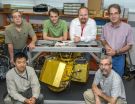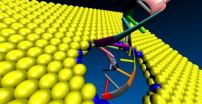(Press-News.org) PHILADELPHIA — Recurrence of hormone-related breast cancer was cut by half in overweight and obese women who regularly used aspirin or other nonsteroidal anti-inflammatory drugs (NSAIDs), according to data published in Cancer Research, a journal of the American Association for Cancer Research.
"Our studies suggest that limiting inflammatory signaling may be an effective, less toxic approach to altering the cancer-promoting effects of obesity and improving patient response to hormone therapy," said Linda A. deGraffenried, PhD, associate professor of nutritional sciences at The University of Texas in Austin.
The study found that women whose body mass index (BMI) was greater than 30 and had estrogen receptor alpha (ERα)-positive breast cancer had a 52 percent lower rate of recurrence and a 28-month delay in time to recurrence if they were taking aspirin or other NSAIDs.
"These results suggest that NSAIDs may improve response to hormone therapy, thereby allowing more women to remain on hormone therapy rather than needing to change to chemotherapy and deal with the associated side effects and complications," said deGraffenried. "However, these results are preliminary and patients should never undertake any treatment without consulting with their physician."
Using blood from obese patients, deGraffenried and colleagues conducted experiments in the laboratory to recreate a tumor environment containing cancer cells, fat cells, and the immune cells that promote inflammation. They found that the factors associated with obesity initiate a network of signaling within the tumor environment to promote growth and resistance to therapy.
"These studies show that the greatest benefit from aspirin [and other NSAIDs] will be in those with a disease driven by inflammation, and not just obesity," explained DeGraffenried.
Researchers used data from 440 women diagnosed with invasive, ERα-positive breast cancer and treated at The University of Texas Health Science Center and the START Center for Cancer Care clinic, both in San Antonio, Texas, between 1987 and 2011.
Of the women studied, 58.5 percent were obese and 25.8 percent were overweight. About 81 percent took aspirin, and the rest took another NSAID. About 42 percent and 25 percent took statins and omega-3 fatty acid, respectively.
There was an indication of protection from aspirin and other NSAIDs even after controlling for statins and omega-3 fatty acid use, which also have anti-inflammatory effects.
INFORMATION:
This study was funded by the U.S. Department of Defense, the Breast Cancer Research Program of the Congressionally Directed Medical Research Programs, and the National Cancer Institute. DeGraffenried declares no conflicts of interest.
Follow us: Cancer Research Catalyst http://blog.aacr.org; Twitter @AACR; and Facebook http://www.facebook.com/aacr.org
About the American Association for Cancer Research
Founded in 1907, the American Association for Cancer Research (AACR) is the world's oldest and largest professional organization dedicated to advancing cancer research and its mission to prevent and cure cancer. AACR membership includes more than 34,000 laboratory, translational, and clinical researchers; population scientists; other health care professionals; and cancer advocates residing in more than 90 countries. The AACR marshals the full spectrum of expertise of the cancer community to accelerate progress in the prevention, biology, diagnosis, and treatment of cancer by annually convening more than 20 conferences and educational workshops, the largest of which is the AACR Annual Meeting with more than 18,000 attendees. In addition, the AACR publishes eight peer-reviewed scientific journals and a magazine for cancer survivors, patients, and their caregivers. The AACR funds meritorious research directly as well as in cooperation with numerous cancer organizations. As the Scientific Partner of Stand Up To Cancer, the AACR provides expert peer review, grants administration, and scientific oversight of team science and individual grants in cancer research that have the potential for near-term patient benefit. The AACR actively communicates with legislators and policymakers about the value of cancer research and related biomedical science in saving lives from cancer. For more information about the AACR, visit http://www.AACR.org.
NSAIDs may lower breast cancer recurrence rate in overweight and obese women
2014-08-14
ELSE PRESS RELEASES FROM THIS DATE:
Mayo Clinic challenges some recommendations in updated cholesterol treatment guideline
2014-08-14
A Mayo Clinic task force challenges some recommendations in the updated guideline for cholesterol treatment unveiled by the American College of Cardiology (ACC) and American Heart Association (AHA) in 2013. The task force concludes, based on current evidence, that not all patients encouraged to take cholesterol-lowering medications, such as statins, may benefit from them and that the guideline missed some important conditions that might benefit from medication.
Furthermore, the task force believes an emphasis needs to be placed on an individualized treatment approach ...
NSAIDs benefit overweight breast cancer patients, study finds
2014-08-14
AUSTIN, Texas — Researchers have determined that postmenopausal overweight or obese breast cancer patients receiving hormone therapy as part of their treatment and who use nonsteroidal anti-inflammatory drugs (NSAIDs) such as aspirin or ibuprofen have significantly lower breast cancer recurrence rates and a sizable delay in time to cancer recurrence.
The findings, published in the Aug. 14 edition of Cancer Research, suggest a new possibility for reducing the incidence of breast cancer recurrence among overweight and obese postmenopausal women, who have a comparatively ...
Scientists make major breakthrough in understanding leukemia
2014-08-14
Scientists from Queen Mary University of London (QMUL) have discovered mutations in genes that lead to childhood leukaemia of the acute lymphoblastic type – the most common childhood cancer in the world.
The study was conducted amongst children with Down's syndrome – who are 20-50 times more prone to childhood leukaemias than other children – and involved analysing the DNA sequence of patients at different stages of leukaemia.
The researchers uncovered that two key genes (called RAS and JAK) can mutate to turn normal blood cells into cancer cells. However, these ...
Can our computers continue to get smaller and more powerful?
2014-08-13
From their origins in the 1940s as sequestered, room-sized machines designed for military and scientific use, computers have made a rapid march into the mainstream, radically transforming industry, commerce, entertainment and governance while shrinking to become ubiquitous handheld portals to the world.
This progress has been driven by the industry's ability to continually innovate techniques for packing increasing amounts of computational circuitry into smaller and denser microchips. But with miniature computer processors now containing millions of closely-packed transistor ...
UT Arlington team's work could lead to earlier diagnosis, treatment of mental diseases
2014-08-13
A computer science and engineering associate professor and her doctoral student graduate are using a genetic computer network inference model that eventually could predict whether a person will suffer from bipolar disorder, schizophrenia or another mental illness.
The findings are detailed in the paper "Inference of SNP-Gene Regulatory Networks by Integrating Gene Expressions and Genetic Perturbations," which was published in the June edition of Biomed Research International. The principal investigators were Jean Gao, an associate professor of computer science and engineering, ...
Three radars are better than one: Field campaign demonstrates two new instruments
2014-08-13
Putting three radars on a plane to measure rainfall may seem like overkill. But for the Integrated Precipitation and Hydrology Experiment field campaign in North Carolina recently, more definitely was better.
The three instruments, developed by the High Altitude Radar group at NASA's Goddard Space Flight Center in Greenbelt, Maryland, flew as part of the Global Precipitation Measurement (GPM) mission's six-week ground-validation program that took place May 1 through June 15 in the southern Appalachians, specifically to measure rain in difficult-to-forecast mountain regions. ...
New material could enhance fast and accurate DNA sequencing
2014-08-13
CHAMPAIGN, Ill. — Gene-based personalized medicine has many possibilities for diagnosis and targeted therapy, but one big bottleneck: the expensive and time-consuming DNA-sequencing process.
Now, researchers at the University of Illinois at Urbana-Champaign have found that nanopores in the material molybdenum disulfide (MoS2) could sequence DNA more accurately, quickly and inexpensively than anything yet available.
"One of the big areas in science is to sequence the human genome for under $1,000, the 'genome-at-home,'" said Narayana Aluru, a professor of mechanical ...
Patent examiners more likely to approve marginal inventions when pressed for time
2014-08-13
CHAMPAIGN, Ill. — Haste makes waste, as the old saying goes. And according to research from a University of Illinois expert in patent law, the same adage could be applied to the U.S. Patent and Trademark Office, where high-ranking examiners have a tendency to rubber-stamp patents of questionable merit due to time constraints.
The less time patent examiners are given to review an application, the more likely they are to grant patent protection to inventions "on the margin," says a study co-authored by Melissa Wasserman, the Richard and Anne Stockton Faculty Scholar and ...
Bones from nearly 50 ancient flying reptiles discovered
2014-08-13
Scientists discovered the bones of nearly 50 winged reptiles from a new species, Caiuajara dobruskii, that lived during the Cretaceous in southern Brazil, according to a study published August 13, 2014 in the open-access journal PLOS ONE by Paulo Manzig from Universidade do Contestado, Brazil, and colleagues.
The authors discovered the bones in a pterosaur bone bed in rocks from the Cretaceous period. They belonged to individuals ranging from young to adult, with wing spans ranging from 0.65-2.35m, allowing scientists to analyze how the bones fit into their clade, but ...
Embalming study 'rewrites' chapter in Egyptian history
2014-08-13
The origins of mummification may have started in ancient Egypt 1,500 years earlier than previously thought, according to a study published August 13, 2014 in the open-access journal PLOS ONE by Stephen Buckley from University of York and colleagues from Macquarie University and University of Oxford.
Previous evidence suggests that between ~4500 B.C. and 3100 B.C., Egyptian mummification consisted of bodies desiccating naturally through the action of the hot, dry desert sand. The early use of resins in artificial mummification has, until now, been limited to isolated occurrences ...





